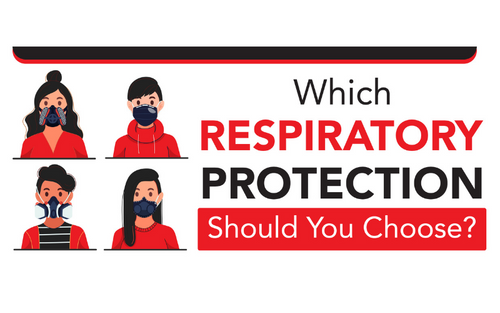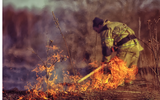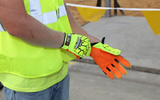Which Respiratory Protection Should You Choose?

Finding the right respiratory protection depends on the types of hazards present in the job site. Respirators work by either filtering particles from the air, absorbing certain chemicals (purifying) from the air, or supplying clean air from an outside source. Here are some respiratory protection options to choose from.
Particulate respirators filter out dust, fumes (metal vapors), and mists, and are usually disposable dust masks or respirators with disposable filters. They should be replaced when clogged or difficult to breathe, discolored, or damaged.
Dust mask respirator
Disposable half facepiece respirators filter out particles, but they do not protect against gases and vapors. Select from particulate respirator categories that have NIOSH approval ratings which include: N (not resistant to oil), R (somewhat resistant to oil, but only for a single shift or 8 hours of continuous/intermittent use), P (resistant to oil, follow manufacturer’s time use limitations). Efficiency ratings indicate the expected percentage of particles 0.3 microns or greater in size that the filter will trap: 100 (as efficient as a HEPA filter), 99, and 95.
Gas mask respirators/chemical cartridges use replaceable chemical cartridges or canisters to remove contaminants. These may require more than one cartridge to protect against multiple hazards, and they are color-coded to help with selecting the right one.
Half Facepiece Respirator
When paired with replaceable cartridges or filters, these respirators can offer protection against certain gases, vapors, or particles. They cover your nose and mouth and require fit testing.
Full Facepiece Respirator
Offering additional eye protection since these cover your entire face, full facepiece respirators have reusable facepieces and replaceable canisters, cartridges, or filters. They have an effective face seal and fit testing is required.
Self-contained breathing apparatus respirators provide clean air from a portable air tank when the air around you is simply too dangerous to breathe (IDLH).
Powered Air-Purifying Respirator (PAPR)
Battery-powered with a blower that pulls air through attached filters, canisters, or cartridges that help protect against gases, vapors, or particles. Components are reusable and filters and cartridges are replaceable. They offer eye protection and low breathing resistance. Loose-fitting PAPRs do not require fit testing and are facial-hair friendly.
Supplied-Air Respirator
Connected to a separate source that supplies clean compressed air through a hose, these respirators are lightweight and used for long periods of time in environments not immediately dangerous to life and health (IDLH)
Self-Contained Breathing Apparatus (SCBA)
Used when entering or escaping from atmospheres considered to be IDLH. SBCAs are commonly used by firefighters and contain their own breathing air supply. They can also protect against higher concentrations of dangerous chemicals. They commonly consist of a full face mask and compressed air tank, and include a regulator valve. Standard SCBAs are rated in length of service, usually 30, 45 and 60 minute versions.
Please note this is a guide and if you have any specific questions or need further assistance in finding the best respirator for your job, give our safety experts at PK Safety a call at 800-829-9580 or email pks-store@pksafety.com.
Recent Posts
-
Customizing Gas Detectors: Tailoring Solutions to Fit Your Unique Requirements
In today’s diverse industrial landscape, a one-size-fits-all approach to safety simply doesn’t cu …Jul 3rd 2024 -
10 Ways to Prevent Wildfires
You can prevent wildfires by extinguishing flames before you leave the worksite. Avoid practicing …Jul 1st 2024 -
ANSI/ISEA 138 Safety Gloves: Ensuring Hand Protection
The human hand is an anatomical masterpiece and arguably the greatest tool attached to our bodies …Jun 25th 2024





